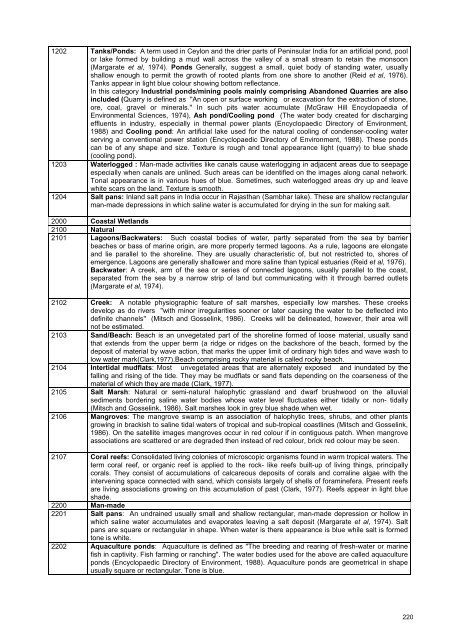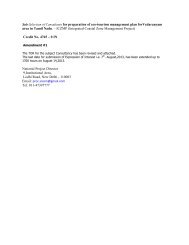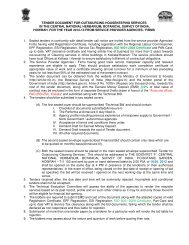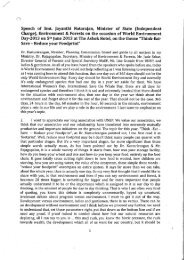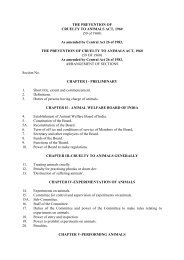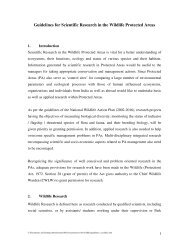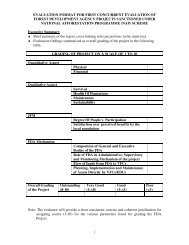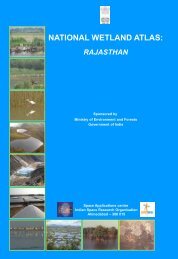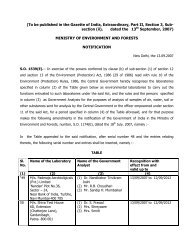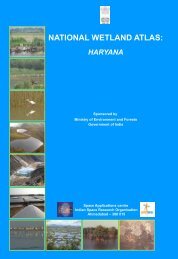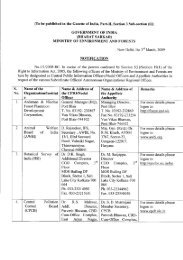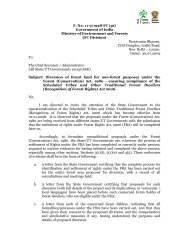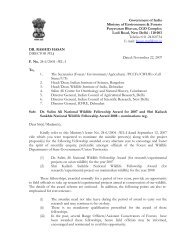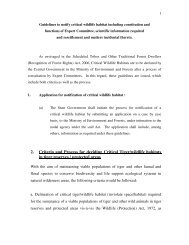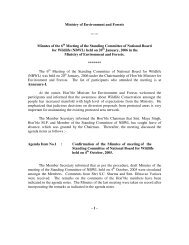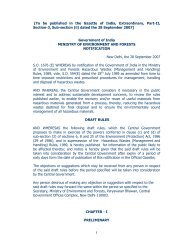Bihar - Ministry of Environment and Forests
Bihar - Ministry of Environment and Forests
Bihar - Ministry of Environment and Forests
- No tags were found...
Create successful ePaper yourself
Turn your PDF publications into a flip-book with our unique Google optimized e-Paper software.
1202 Tanks/Ponds: A term used in Ceylon <strong>and</strong> the drier parts <strong>of</strong> Peninsular India for an artificial pond, pool<br />
or lake formed by building a mud wall across the valley <strong>of</strong> a small stream to retain the monsoon<br />
(Margarate et al, 1974). Ponds Generally, suggest a small, quiet body <strong>of</strong> st<strong>and</strong>ing water, usually<br />
shallow enough to permit the growth <strong>of</strong> rooted plants from one shore to another (Reid et al, 1976).<br />
Tanks appear in light blue colour showing bottom reflectance.<br />
In this category Industrial ponds/mining pools mainly comprising Ab<strong>and</strong>oned Quarries are also<br />
included (Quarry is defined as "An open or surface working or excavation for the extraction <strong>of</strong> stone,<br />
ore, coal, gravel or minerals." In such pits water accumulate (McGraw Hill Encyclopaedia <strong>of</strong><br />
<strong>Environment</strong>al Sciences, 1974), Ash pond/Cooling pond (The water body created for discharging<br />
effluents in industry, especially in thermal power plants (Encyclopaedic Directory <strong>of</strong> <strong>Environment</strong>,<br />
1988) <strong>and</strong> Cooling pond: An artificial lake used for the natural cooling <strong>of</strong> condenser-cooling water<br />
serving a conventional power station (Encyclopaedic Directory <strong>of</strong> <strong>Environment</strong>, 1988). These ponds<br />
can be <strong>of</strong> any shape <strong>and</strong> size. Texture is rough <strong>and</strong> tonal appearance light (quarry) to blue shade<br />
(cooling pond).<br />
1203 Waterlogged : Man-made activities like canals cause waterlogging in adjacent areas due to seepage<br />
especially when canals are unlined. Such areas can be identified on the images along canal network.<br />
Tonal appearance is in various hues <strong>of</strong> blue. Sometimes, such waterlogged areas dry up <strong>and</strong> leave<br />
white scars on the l<strong>and</strong>. Texture is smooth.<br />
1204 Salt pans: Inl<strong>and</strong> salt pans in India occur in Rajasthan (Sambhar lake). These are shallow rectangular<br />
man-made depressions in which saline water is accumulated for drying in the sun for making salt.<br />
2000 Coastal Wetl<strong>and</strong>s<br />
2100 Natural<br />
2101 Lagoons/Backwaters: Such coastal bodies <strong>of</strong> water, partly separated from the sea by barrier<br />
beaches or bass <strong>of</strong> marine origin, are more properly termed lagoons. As a rule, lagoons are elongate<br />
<strong>and</strong> lie parallel to the shoreline. They are usually characteristic <strong>of</strong>, but not restricted to, shores <strong>of</strong><br />
emergence. Lagoons are generally shallower <strong>and</strong> more saline than typical estuaries (Reid et al, 1976).<br />
Backwater: A creek, arm <strong>of</strong> the sea or series <strong>of</strong> connected lagoons, usually parallel to the coast,<br />
separated from the sea by a narrow strip <strong>of</strong> l<strong>and</strong> but communicating with it through barred outlets<br />
(Margarate et al, 1974).<br />
2102 Creek: A notable physiographic feature <strong>of</strong> salt marshes, especially low marshes. These creeks<br />
develop as do rivers "with minor irregularities sooner or later causing the water to be deflected into<br />
definite channels" (Mitsch <strong>and</strong> Gosselink, 1986). Creeks will be delineated, however, their area will<br />
not be estimated.<br />
2103 S<strong>and</strong>/Beach: Beach is an unvegetated part <strong>of</strong> the shoreline formed <strong>of</strong> loose material, usually s<strong>and</strong><br />
that extends from the upper berm (a ridge or ridges on the backshore <strong>of</strong> the beach, formed by the<br />
deposit <strong>of</strong> material by wave action, that marks the upper limit <strong>of</strong> ordinary high tides <strong>and</strong> wave wash to<br />
low water mark(Clark,1977).Beach comprising rocky material is called rocky beach.<br />
2104 Intertidal mudflats: Most unvegetated areas that are alternately exposed <strong>and</strong> inundated by the<br />
falling <strong>and</strong> rising <strong>of</strong> the tide. They may be mudflats or s<strong>and</strong> flats depending on the coarseness <strong>of</strong> the<br />
material <strong>of</strong> which they are made (Clark, 1977).<br />
2105 Salt Marsh: Natural or semi-natural halophytic grassl<strong>and</strong> <strong>and</strong> dwarf brushwood on the alluvial<br />
sediments bordering saline water bodies whose water level fluctuates either tidally or non- tidally<br />
(Mitsch <strong>and</strong> Gosselink, 1986). Salt marshes look in grey blue shade when wet.<br />
2106 Mangroves: The mangrove swamp is an association <strong>of</strong> halophytic trees, shrubs, <strong>and</strong> other plants<br />
growing in brackish to saline tidal waters <strong>of</strong> tropical <strong>and</strong> sub-tropical coastlines (Mitsch <strong>and</strong> Gosselink,<br />
1986). On the satellite images mangroves occur in red colour if in contiguous patch. When mangrove<br />
associations are scattered or are degraded then instead <strong>of</strong> red colour, brick red colour may be seen.<br />
2107 Coral reefs: Consolidated living colonies <strong>of</strong> microscopic organisms found in warm tropical waters. The<br />
term coral reef, or organic reef is applied to the rock- like reefs built-up <strong>of</strong> living things, principally<br />
corals. They consist <strong>of</strong> accumulations <strong>of</strong> calcareous deposits <strong>of</strong> corals <strong>and</strong> corraline algae with the<br />
intervening space connected with s<strong>and</strong>, which consists largely <strong>of</strong> shells <strong>of</strong> foraminefera. Present reefs<br />
are living associations growing on this accumulation <strong>of</strong> past (Clark, 1977). Reefs appear in light blue<br />
shade.<br />
2200 Man-made<br />
2201 Salt pans: An undrained usually small <strong>and</strong> shallow rectangular, man-made depression or hollow in<br />
which saline water accumulates <strong>and</strong> evaporates leaving a salt deposit (Margarate et al, 1974). Salt<br />
pans are square or rectangular in shape. When water is there appearance is blue while salt is formed<br />
tone is white.<br />
2202 Aquaculture ponds: Aquaculture is defined as "The breeding <strong>and</strong> rearing <strong>of</strong> fresh-water or marine<br />
fish in captivity. Fish farming or ranching". The water bodies used for the above are called aquaculture<br />
ponds (Encyclopaedic Directory <strong>of</strong> <strong>Environment</strong>, 1988). Aquaculture ponds are geometrical in shape<br />
usually square or rectangular. Tone is blue.<br />
220


